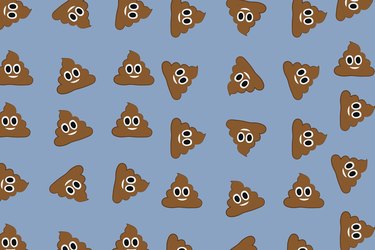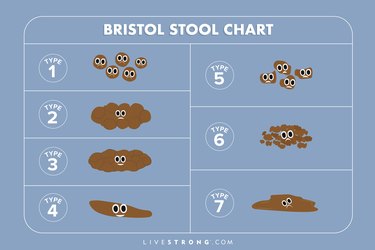
Honestly, don't bother pooping and then dashing. Take a second, turn around and look at what you've just left in the bowl. Because the shape of your poop can clue you into your GI health.
Gut experts can tell you all day what to watch for with your poop, but for a clear visual, you've gotta look at the Bristol Stool Chart, says Jacqueline Wolf, MD, a gastroenterologist at Beth Israel Deaconess Medical Center in Boston and author of A Woman's Guide to a Healthy Stomach.
Video of the Day
Video of the Day
Here's the LIVESTRONG.com version — go ahead and compare what your last poop looked like:

You probably noticed there are seven types — err shapes — of poop, ranging from hard lumps that you might strain to pass all the way to, well, basically the last time you had terrible diarrhea.
So, What's the 'Normal' Shape of Poop?
That would be Type 3 or Type 4 on the chart, says Dr. Wolf. That means your poop will look sausage-like with some cracks in it or like a smooth snake. Both are easy to pass with no straining. Basically, it doesn't hurt to go, and it's likely a sign that you're regular, eat a good amount of fiber and drink adequate water throughout the day.
One note: Some people think that an ideal poop is shaped like an "S." If yours doesn't look like this, though, don't stress. And if it does, there's no reason to brag. "I don't know why stool would be shaped like an S, other than the way it sits in someone's rectum," Dr. Wolf says.
There really isn't a "perfect" poop shape to aim for, because there are several healthy stool shapes. On the other hand, if you fall on either end of the chart, then there may be an issue to look into.
Lumpy Poop
For instance, Type 1 or Type 2 is lumpy poop — either it'll be like dropping little pebbles or rocks into the toilet (and perhaps having to work to push them out) or your stool will look like a bunch of lumps stuck together — and it typically means you're constipated.
If you're constipated, then your first course of action is to either eat foods rich in fiber (raspberries, avocados, lentils, whole grain cereals) or take a fiber supplement, Dr. Wolf says. Good options include Benefiber, Citrucel, Metamucil and FiberCon, she says.
Remember to drink water along with the extra fiber you're taking, to help move it along in your system.
Still stopped-up? Stool softeners like Colace or Miralax draw water into the stool to help make it easier to pass, Dr. Wolf says. These aren't long-term solutions for constipation, though, and if you find you need to use them all the time to turn your Type 1 poop into a Type 3, then you really should talk to your doctor.
Loose Poop
Finally, there's the diarrhea side, the Type 5, 6 and 7. These range between what your mom would call "loose stools" and full-on diarrhea, where you're pooping out all liquid.
"Type 6 or 7 isn't usually happening all the time," Dr. Wolf says.
Diarrhea is defined as having loose stools three or more times a day, and a single bout of diarrhea — possibly caused by a virus or "food poisoning" — happens to most adults about once a year and usually goes away on its own, according to the U.S. National Library of Medicine.
Chronic diarrhea, on the other hand, lasts for at least four weeks and might be a sign of an underlying problem, such as irritable bowel syndrome (IBS), Crohn's disease, lactose intolerance or other food sensitivities.
Related Reading
What's Normal for You?
One of the reasons it's important to look at your stool after you poop is to know what your normal is.
"Some people run at a Type 2 or Type 5 their whole life. They don't necessarily need to get an evaluation from their doctor to see if something is wrong," Dr. Wolf says. "But if you experience a change in stools or notice other symptoms — like abdominal pain or weight loss with diarrhea — you might need to make an appointment with your provider to see if something else is going on."
Is this an emergency? If you are experiencing serious medical symptoms, please see the National Library of Medicine’s list of signs you need emergency medical attention or call 911.